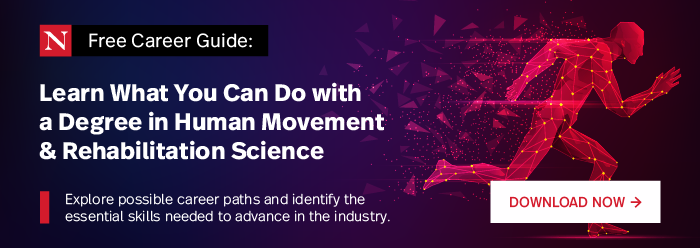If you’re interested in the movement of the human body, several degrees can lead you to a fulfilling career path within related fields. To determine which advanced degrees will best help you achieve your professional goals, it’s important to understand the difference between available programs, especially closely related degrees like human movement and rehabilitation sciences and exercise science.
While these degree programs share some similarities, there are key differentiators between the two that will help you decide which area of study will better suit your career goals. Human movement and rehabilitation sciences focus on understanding the physics and behavioral aspects of how and why humans move. Human movement and rehabilitation sciences also look at the neural control of movement in response to injury through rehabilitation.
In comparison, exercise science primarily focuses on the prevention and treatment of metabolic diseases, such as diabetes, while considering physical activity as a means to health. While both disciplines share some foundational knowledge, human movement and rehabilitation sciences are more reactive to injury and deformities, whereas exercise science is more reactive to health complications.
Interested in a Career in Human Movement Science?
Download our free guide to learn the skills you need to advance in the industry.
What Is an MS in Human Movement?
An MS in Human Movement and Rehabilitation Sciences studies how people move in different contexts and how their movement relates to the analysis, improvement, and recovery of physical activity. This degree focuses on typical day-to-day human movement, including the physics, behavior, and motivation of how the body reacts to movement. An MS in Human Movement and Rehabilitation Sciences prepares students and the next generation of scientists to optimize bodily performance by focusing on:
- Biomechanics
- Control of movement
- Health and well-being through movement and design
- Human-cybernetic system interactions
- Musculoskeletal disorders
- Motor learning
- Neurorehabilitation of movement and function
In other words, at Northeastern University’s Bouvé College of Health Sciences, human movement and rehabilitation sciences are where engineering intersects with Northeastern’s College of Science. The program investigates how our joints move and our bodies react to physical and mechanical stress, often dealing with issues related to injury and rehabilitation. Human movement and rehabilitation sciences also examine how healthy people move and interact with the environment—and how the environment can impact movement.
What Is an MS in Exercise Science?
Exercise science leverages research to apply active solutions that can support individuals suffering from health issues from physical inactivity. An MS in Exercise Science provides students with the foundation for understanding advanced principles of exercise physiology. This includes acute and chronic responses to endurance and strength exercise in major body systems, including the cardiopulmonary and musculoskeletal systems. Core areas of study include:
- Advanced Exercise Physiology
- Cardiopulmonary Physiology
- Electrocardiography
- Physical Activity and Exercise: Effects on Musculoskeletal Health and Disease
- Physical Activity and Exercise: Prescription, Measurement, and Testing
Exercise science aims to measure and understand the metabolic aspects of movement and exercise around things like heart disease. For example, when exercise science students study running, they might look at the effects of running on heart performance, VO2 uptake, and heart rate. In comparison, when human movement and rehabilitation sciences students study running, they consider how the knees and legs move and, if there is a deformity, how a change in shoes can impact how joints move differently.
Which Program Is Right for You?
Now that you understand some key differences between an MS in Human Movement and Rehabilitation Sciences versus an MS in Exercise Science, it’s time to decide which path is better for you. To recap, human movement and rehabilitation sciences concentrate on understanding the biomechanics of movement, whereas exercise science focuses on the physiological effects of movement.
An MS in Human Movement and Rehabilitation Sciences is for those who generally want to understand how the biomechanics of movement work rather than the physiological effects of movement on control. This degree supports career paths including engineering, product and therapy development, healthcare, research, and academia. Human movement and rehabilitation scientists also focus on specific deformities and are often tasked with customizing and designing prosthetics unique to a person’s needs. For example, they may work with patients in an orthopedic unit using a new running shoe or brace.
An MS in Exercise Science may be a better fit if you want to help people get and stay healthy through exercise. An exercise scientist often takes courses in nutrition, working with doctors to improve people’s nutrition, for example, and reduce the risk of cardiovascular issues by changing their cholesterol levels. Exercise science analyzes the clinical aspects more broadly, so these graduates often work in hospitals, gyms, nutritionist offices, physical therapy, or occupational therapy clinics. Bouvé College of Health Sciences offers an online Master of Science in Exercise Science for professionals aiming to promote health. The program includes a range of immersive experiences with a foundation of theoretical knowledge.”
To jumpstart your career in human movement and rehabilitation sciences, learn more about Northeastern’s program that will provide you with the essential skills needed to thrive and advance in the industry.
Download our free career guide for everything you need to know about breaking into the field of human movement and rehabilitation sciences.







Related Articles
Human Movement Science vs. Kinesiology: What’s the Difference?
Is an MS in Human Movement & Rehabilitation Science Worth It?
What Can You Do With a Human Movement & Rehabilitation Science Degree?